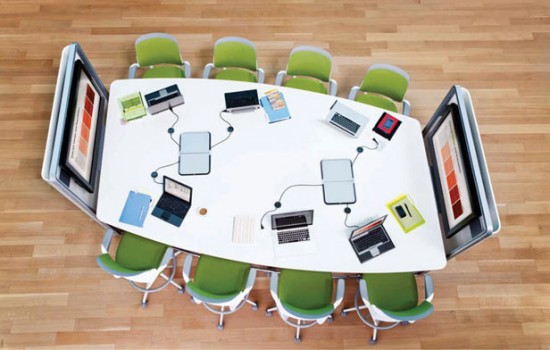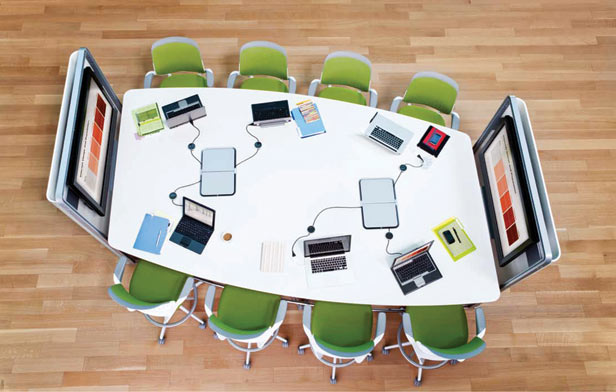Business Impact
Smashing the Cubicles
By designing new spaces around tablets, smart phones, and social technologies, companies can operate with far fewer desks.



The quick expansion of social and mobile technologies is creating a widely distributed workforce. To better suit employees who come into offices more sporadically, some companies and design firms are testing radically new and more efficient configurations for physical offices, betting that improved technology will make the experiment more successful than similar ones in the 1990s.
A project at the headquarters of Cisco Systems in San Jose, California, for example, overthrows decades-old conventions about office space. Called Connected Workplace, it replaces individual cubicles with open clusters of wheeled desks that belong to groups, not individuals; personal belongings are largely confined to lockers.
There are no PCs at the desks, because employees use mobile technologies, including the Cius tablet, which Cisco recently began selling to businesses. Rick Hutley, a Cisco vice president, chooses his desk according to which colleagues are present and what’s on the day’s agenda. Then he docks his Cius to a desktop port that includes a phone handset. The tablet handles voice and video calls whether it’s docked or mobile, and it can be used to share documents at meetings.
It can also be plugged into a monitor and keyboard to be used like a full PC. “You can walk around with your entire world with you in this device,” Hutley says. “My laptop would often stay on my desk, but the tablet never does.” If he needs to make a private voice or video call, he can step into one of the rooms at the edges of the cluster.
Employees can also participate in the company’s corporate social network, Quad, which is accessible on the Web or through the iPhone, iPad, or Cius. People can post meeting requests, give status updates on projects, and quickly get in touch via instant messages, voice calls, or e-mail.
Cisco’s vision is an example of a broader effort to reshape office technologies and environments. “We used to have boring stuff at work and more interesting technology at home,” says Prith Banerjee, leader of Hewlett-Packard’s research arm. “Now office technology will make use of the same cool experiences and interfaces.”
Among other things, Banerjee predicts that flexible, paperlike color displays will eventually blur the boundary between phones and tablets, creating mobile devices better suited to serving as an entire office.
Such changes could save a lot of money. Cisco’s project, for example, was launched after an internal study found that cubicles were vacant two-thirds of the time while people roamed the campus or worked remotely. Company calculations show that the building used for the project can accommodate 140 employees, up from 88 in designs used in traditional Cisco buildings, and that real-estate costs should drop by 37 percent.
Over the long term, Cisco hopes to save on health costs, too, because people who move around more frequently are less likely to suffer health problems. The company is planning to study whether the more mature technology of today can conquer resistance that hobbled previous attempts to build offices with little private space.
Meanwhile, office design firms are stepping in with complementary ideas. Steelcase, for example, is building office installations that allow for spontaneous meetings and collaboration. Mobile-device ports are built into conference tables or semiprivate pods, and some allow people to take turns projecting data on a common screen.